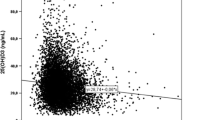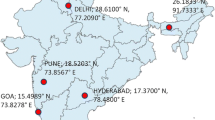Abstract
The lack of vitamin D is a major changeable factor involved in the pathophysiology of osteoporosis. Since the major source for this hormone is its cutaneous synthesis via ultraviolet radiation (UVR), we studied the serum level of 25-hydroxyvitamin D (25OHD) in 250 free-living elderly people (79.1 years old) from a subtropical region according to the UVR incidence and its correlations with parathormone (PTH) and ionized calcium. UVR and 25OHD differed according to the season of the year (P<0.001), with greater radiation in the summer and less in the winter, whereas the 25OHD peak and nadir occurred in autumn and spring, respectively. The highest 25OHD mean was 67.2 nmol/l, and the lowest was 29.1 nmol/l corresponding, respectively, to the measure of the month subsequent to the one of most and least sunlight incidence. Clustered by season, the correlation between UVR and 25OHD for the following seasons was r =0.98 and between the PTH and 25OHD of corresponding seasons, r =–0.95. Vitamin D deficiency occurred in 15.4% of patients, insufficiency in 41.9% and secondary hyperparathyroidism in 55%. In conclusion, we found a seasonal variation in 25OHD levels that strongly correlated with the PTH levels when separated by the seasons of the year. The 25OHD levels correlated with the UVR of the previous quarter, requiring no less than 30 days for serum changes arising from exposure to or deprivation of UVR to be observed. The prevalence of vitamin D deficiency/insufficiency found was greater than expected, even when compared to countries exposed to less solar irradiation. Thus, measures to encourage greater sun exposure and food enrichment policies should also be considered.

Similar content being viewed by others
References
Kinyamu HK, Gallagher JC, Balhorn KE, Petranick KM, Rafferty KA (1997) Serum vitamin D metabolites and calcium absorption in normal young and elderly free-living women and in women living in nursing homes. Am J Clin Nutr 65:790–797
Goulding A (1995) Lightening the fracture load: growing evidence suggests many older New Zealanders would benefit from more vitamin D (editorials). N Z Med J 112:1095
LeBoff MS, Kohlmeier L, Hurwitz S, Franklin J, Wright J, Glowacki J (1999) Occult vitamin D deficiency in postmenopausal US women with acute hip fracture. JAMA 281:1505–1511
Holick MF (2004) Vitamin D: importance in the prevention of cancer, type 1 diabetes, heart disease, and osteoporosis. Am J Clin Nutr 79:362–371
Inderjeeth CA, Nicklason F, Al-Lahham Y, Greenaway TM, Jones G, Parameswaran VV, David R (2000) Vitamin D deficiency and secondary hyperparathyroidism: clinical and biochemical associations in older non-institutionalized southern Tasmanians. Aust NZ J Med 30:209–214
Lips P, Duong T, Oleksik A, Black D, Cummings S, Cox D, Nickelsen T (2001) A global study of vitamin D status and parathyroid function in postmenopausal women with osteoporosis: baseline data from the multiple outcomes of raloxifen evaluation clinical trial. J Clin Endocrinol Metabol 86:1212–1221
Olivieri MB, Mautalen C, Bustamante L, García VG (1994) Serum levels of 25-hydroxyvitamin D in a year of residence on the Antarctic continent. Eur J Clin Nutr 48: 397–401
Ramos LR, Toniolo J, Cendoroglo MS et al (1998) Two-year follow-up study of elderly residents in S. Paulo, Brazil: methodology and preliminary results. Rev Saúde Publica 32:397–407
Fritzpatrick TB (1988) The validity and practicality of sun-reactive skin types I to VI. Arch Dermatol 124:869–871
Ishimura E, Nishizawa Y, Inaba M, Matsumoto N, Emoto M, Kawagishi T, Shoje S, Okuno S Kim M, Miki T, Morii H (1999) Serum levels of 1,25-dihydroxyvitamin D, 24,25-dihydroxyvitamin D, and 25-dihydroxyvitamin D in nondialyzed patients with chronic renal failure. Kidney Int 55:1019–1027
McKenna MJ, Freaney R (1998) Secondary hyperparthyroidism in the elderly: means to defining hypovitaminosis D. Osteoporos Int [Suppl] 8:S3–S6
Vieira JG, Nishida SK, Kasamatsu TS, Amarante EC, Kunii IS (1994) Development and clinical application of an immunofluorometric assay for intact parathyroid hormone. Braz J Med Biol Res 27:2379–2382
Corrêa MP, Dubuisson P, Plana-Fattori A (2003) An overview about the ultraviolet index and the skin cancer cases in Brazil. Photochem Photobiol 78:49–54
Mc Clatchey RA, Fenn RW, Selby JEA, Volz FE, Garing JS (1972) Optical properties of the atmosphere (3rd edn). Air Force Cambridge Res Lab, Publ AFCRL-72-0497
Chapuy MC, Shott AM, Garnero P, Hans D, Delmas PD, Meunier PJ (1996) Healthy elderly French women living at home have secondary hyperparathyroidism and high bone turnover in winter. EPIDOS Study Group. J Clin Endocrinol Metab 81:1129–1133
Visser M, Deeg DJH, Lips P (2003) Low vitamin D and high parathyroid hormone levels as determinants of loss of muscle strength and muscle mass (Sarcopenia): The Longitudinal Aging Study Amsterdam. J Clin Endocrinol Metabol 88:5766–5772
Aguado P, Campo MT, Garcés MV, González-Casaús ML, Bernad M, Gijón-Baños J, Mola WM, Torrijos A, Martinez ME (2000) Low vitamin D levels in outpatient postmenopausal women from a rheumatology clinic in Madrid, Spain: their relationship with bone mineral density. Osteoporos Int 11:739–744
Gannage-Yarred MH, Chemali R, Yaacoub N, Halaby G (2000) Hypovitaminosis D in a sunny country: Relation to lifestyle and bone markers. J Bone Miner Res 15:1856–1862
Bhattoa HP, Bittembuk P, Ganachary S, Balogah A (2003) Prevalence and seasonal variation of hypovitaminosis D and its relationship to bone metabolism in community dwelling postmenopausal Hungarian women. Osteoporos Int 15:447–451
McGrath J, Kimlin MG, Saha S, Eyles DW, Parisi AV (2001) Vitamin D insufficiency in South-East Queensland. Med J Aust 174:150–151
Holick MF (1981) The cutaneous photosynthesis of previtamin D3: a unique photoendocrine system. J Invest Dermatol 77:51–58
Vieth R (1999) Vitamin D supplementation, 25-hydroxyvitamin D concentrations, and safety. Am J Clin Nutr 69:842–856
Ladizesky M, Lu Z, Oliveri B, Roman NS, Diaz S, Holick MF, Mautalen C (1995) Solar ultraviolet B radiation and photoproduction of vitamin D3 in the central and southern areas of Argentina. J Bone Miner Res 10:545–549
Pasco JA, Henry MJ, Kotowicz MA, Sanders KM, Seeman E, Pasco JR, Schneider HG, Nicholson GC (2004) Seasonal periodicity of serum vitamin D and parathyroid hormone, bone resorption and fractures: the Geelong Osteoporosis Study. J Bone Miner Res 19:752–758
Author information
Authors and Affiliations
Corresponding author
Rights and permissions
About this article
Cite this article
Saraiva, G.L., Cendoroglo, M.S., Ramos, L.R. et al. Influence of ultraviolet radiation on the production of 25 hydroxyvitamin D in the elderly population in the city of São Paulo (23 o 34’S), Brazil. Osteoporos Int 16, 1649–1654 (2005). https://doi.org/10.1007/s00198-005-1895-3
Received:
Accepted:
Published:
Issue Date:
DOI: https://doi.org/10.1007/s00198-005-1895-3




